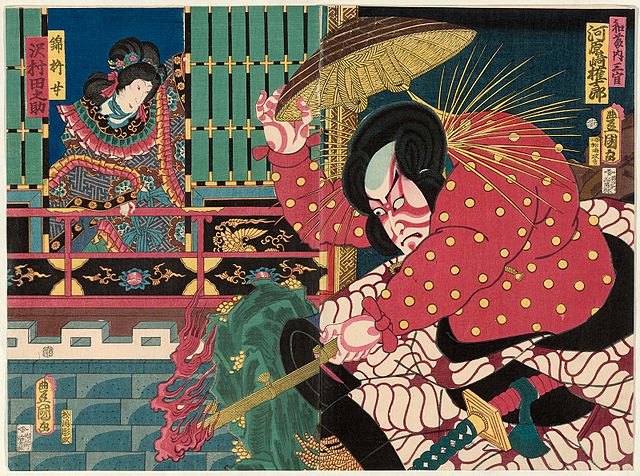The Battles of Coxinga is a puppet play by Chikamatsu Monzaemon. It was his most popular play. First staged on November 26, 1715, in Osaka, it ran for the next 17 months, far longer than the usual few weeks or months. Its enduring popularity can largely be attributed to its effectiveness as entertainment. Its many scenes over more than seven years follow the adventures of Coxinga in restoring the rightful dynasty of China. It features effects uniquely suited for the puppet theater, such as the villain Ri Tōten gouging out an eye. Donald Keene suggests that the adventures in exotic China played well in isolationist Tokugawa Japan. While generally not considered as great in literary quality as some of Chikamatsu's domestic tragedies like The Love Suicides at Amijima, it is generally agreed to be his best historical play.
Watōnai in The Battles of Coxinga, Act III, Scene 2
Kawarazaki Gonjūrō I as Watōnai (right) and Sawamura Tanosuke III as Kinshōjo (left)
Bandō Hikosaburō V as Kanki (right) and Kawarazaki Gonjūrō I as Watōnai (left)
Chikamatsu Monzaemon was a Japanese dramatist of jōruri, the form of puppet theater that later came to be known as bunraku, and the live-actor drama, kabuki. The Encyclopædia Britannica has written that he is "widely regarded as the greatest Japanese dramatist". His most famous plays deal with double-suicides of honor bound lovers. Of his puppet plays, around 70 are jidaimono (時代物) and 24 are sewamono (世話物). The domestic plays are today considered the core of his artistic achievement, particularly works such as The Courier for Hell (1711) and The Love Suicides at Amijima (1721). His histories are viewed less positively, though The Battles of Coxinga (1715) remains praised.
Chikamatsu Monzaemon
Tomb of Chikamatsu at Kōsaiji temple
Statue of Chikamatsu Monzaemon at Amagasaki, Hyogo






